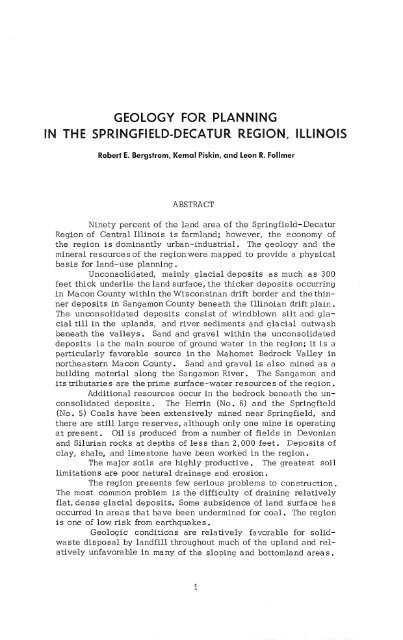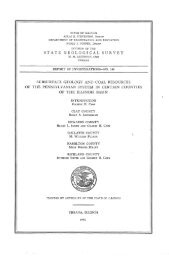Public - University of Illinois at Urbana-Champaign
Public - University of Illinois at Urbana-Champaign
Public - University of Illinois at Urbana-Champaign
Create successful ePaper yourself
Turn your PDF publications into a flip-book with our unique Google optimized e-Paper software.
Robert E. Bergstrom, Kemal Piskin, and Leon R. FollmerABSTRACTNinety percent <strong>of</strong> the land area <strong>of</strong> the Springfield-Dec<strong>at</strong>urRegion <strong>of</strong> Central <strong>Illinois</strong> is farmland; however, the economy <strong>of</strong>the region is dominantly urban-industrial. The geology and themineral re sources <strong>of</strong> the region were mapped to provide a physicalbasis for land-use planning.Unconsolid<strong>at</strong>ed, mainly glacial deposits as much as 300feet thick underlie the land surface, the thicker deposits occurringin Ma con County within the Wi sconsinan drift border and the thinnerdeposits in Sangamon County bene<strong>at</strong>h the Illinoian drift plain.The unconsolid<strong>at</strong>ed deposits consist <strong>of</strong> windblown silt and glacialtill in the uplands, and river sediments and glacial outwashbene<strong>at</strong>h the valleys. Sand and gravel within the unconsolid<strong>at</strong>eddeposits is the main source <strong>of</strong> ground w<strong>at</strong>er in the region; it is aparticularly favorable source in the Mahomet Bedrock Valley innortheastern Macon County. Sand and gravel is also mined as abuilding m<strong>at</strong>erial along the Sangamon River. The Sangamon andits tributaries are the prime surface-w<strong>at</strong>er resources <strong>of</strong> the region.Additional resources occur in the bedrock bene<strong>at</strong>h the unconsolid<strong>at</strong>eddeposits. The Herrin (No. 6) and the Springfield(No. 5) Coals have been extensively mined near Springfield, andthere are still large reserves, although only one mine is oper<strong>at</strong>ing<strong>at</strong> present. Oil is produced from a number <strong>of</strong> fields in Devonianand Silurian rocks <strong>at</strong> depths <strong>of</strong> less than 2,000 feet. Deposits <strong>of</strong>clay, shale, and limestone have been worked in the region.The major soils are highly productive. The gre<strong>at</strong>est soillimit<strong>at</strong>ions are poor n<strong>at</strong>ural drainage and erosion.The region presents few serious problems to construction.The most common problem is the difficulty <strong>of</strong> draining rel<strong>at</strong>ivelyfl<strong>at</strong>, dense glacial deposits. Some subsidence <strong>of</strong> land surface hasoccurred in areas th<strong>at</strong> have been undermined for coal. The regionis one <strong>of</strong> low risk from earthquakes.Geologic conditions are rel<strong>at</strong>ively favorable for solidwastedisposal by landfill throughout much <strong>of</strong> the upland and rel<strong>at</strong>ivelyunfavorable in many <strong>of</strong> the sloping and bottomland areas .
















